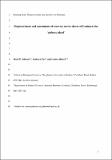| dc.contributor.author | Johnson, Mark P. | en |
| dc.date.accessioned | 2009-09-25T15:40:54Z | en |
| dc.date.available | 2009-09-25T15:40:54Z | en |
| dc.date.issued | 2008 | en |
| dc.identifier.citation | Johnson, M.P., Pye, S, and Allcock, A.L. 2008. Dispersal mode and assessments of recovery on the shores of Gruinard, the 'anthrax island'. Biodiversity and Conservation 17: 721 732. | en |
| dc.identifier.uri | http://hdl.handle.net/10379/310 | en |
| dc.description.abstract | Formaldehyde run-off was an unintended impact of the anthrax decontamination procedure on the island of Gruinard. The death of intertidal organisms was observed where formaldehyde reached the shore during 1986. The extent to which shores on Gruinard have recovered was assessed with survey work in 2000. Recovery estimates were based on the hypothesis that the process of recolonization is partly dependent on species¿ dispersal capability. Underdevelopment of the assemblage of species lacking planktonic dispersal stages (direct developers) is therefore evidence that the process of recolonization is ongoing, rather than complete. A novel multivariate test showed that, when comparing quadrats from Gruinard and nearby mainland shores, assemblages of direct developing molluscs were significantly more distinct than assemblages of molluscs with planktonic dispersal stages. The average densities of species with direct development were generally lower on Gruinard than on mainland shores. While some species with direct development have similar densities on Gruinard and on the surrounding shores, the recovery of the overall assemblage was still incomplete after 14 years. In contrast, the harvested species, Littorina littorea, appeared to benefit from the absence of humans visiting Gruinard¿s shores. Populations of L. littorea on Gruinard contained significantly higher proportions of large individuals. Depending on the dispersal capabilities of different species, Gruinard is either still in recovery or acts as a reserve.
Key words: rafting, recolonization, spatial scale, structure index | en |
| dc.format | application/pdf | en |
| dc.language.iso | en | en |
| dc.publisher | Springer Verlag | en |
| dc.rights | Attribution-NonCommercial-NoDerivs 3.0 Ireland | |
| dc.rights.uri | https://creativecommons.org/licenses/by-nc-nd/3.0/ie/ | |
| dc.subject | Structure index | en |
| dc.subject | Recolonization | en |
| dc.subject | Rafting | en |
| dc.subject | Spatial scale | en |
| dc.subject.lcsh | Spatial ecology | en |
| dc.subject.lcsh | Adaptation (Biology) | en |
| dc.title | Dispersal mode and assessments of recovery on the shores of Gruinard, the 'anthrax island'. | en |
| dc.type | Article | en |
| dc.identifier.doi | 10.1007/s10531-007-9307-y | en |
| dc.local.publishedsource | http://dx.doi.org/10.1007/s10531-007-9307-y | en |
| dc.local.publisherstatement | www.springerlink.com | en |
| dc.description.peer-reviewed | peer-reviewed | en |
| nui.item.downloads | 724 | |


